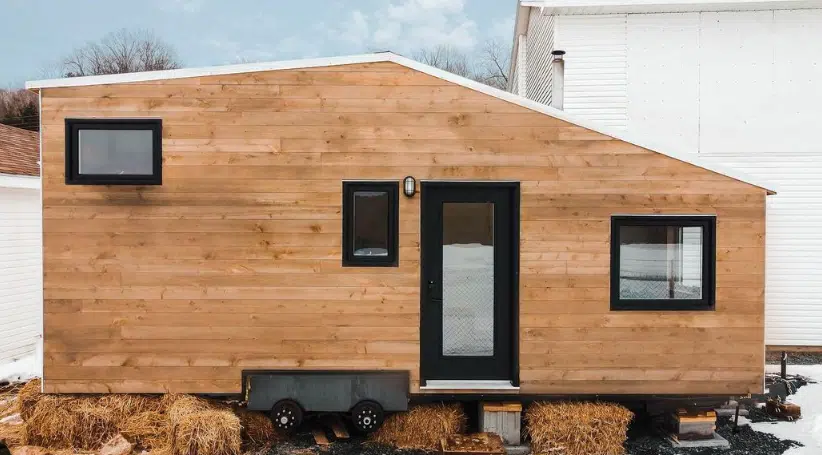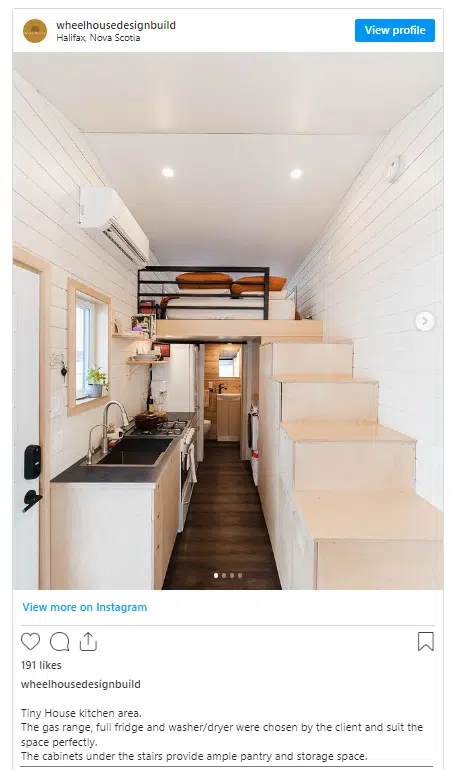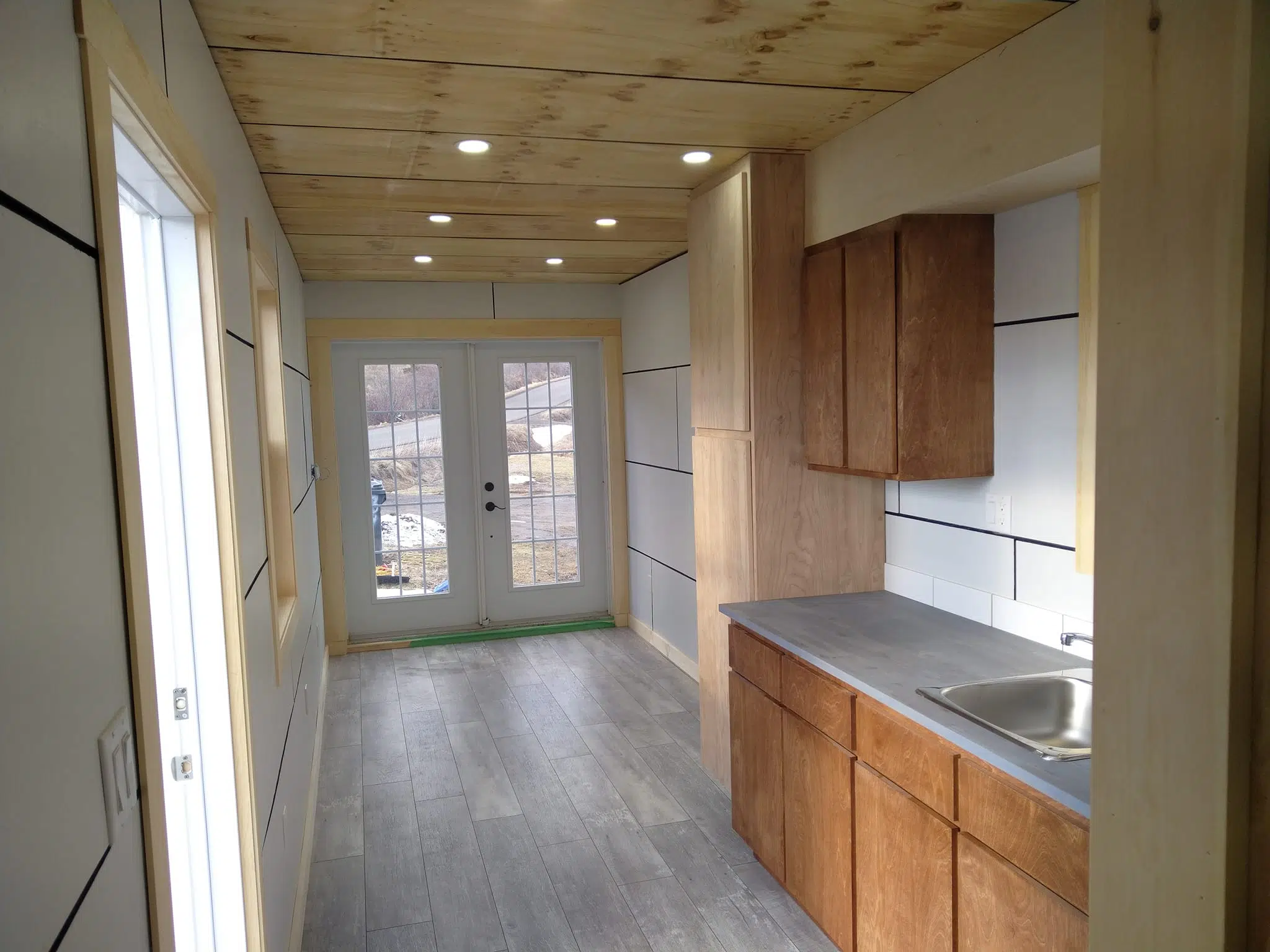
Wheelhouse Design Build Tiny Home. (CREDIT @melcherryy)
Some Nova Scotians are looking to live tiny as more traditional homes climb further out of reach due to soaring costs amid tough pandemic years.
You might think of a tiny home as a trailer on wheels, but they can be any dwelling that takes up fewer than 600 square feet, including houseboats and camper vans. You can embark on minimalistic living, and declutter your space, but also dress them up with expensive decor and high-end hardware.
They’re often self-contained and help you reduce your carbon footprint, so you can skip high energy bills and steep heating costs.
Our newsroom reached out to two tiny home builders in Nova Scotia to learn more about the movement in our province.
André Legault, co-owner of Halifax’s Wheelhouse Design Build, describes what a tiny home means to him.
“They are literally like smaller homes. They don’t have all the amenities of a huge house,” Legault explains. “You’re cutting a lot of fat as far as wasted space. Conventional homes are built with so much. And if you trim that down and ask ‘what do we actually need? What are the essentials? How do we make this efficient,’ then you’re spending a lot less. Tiny homes are still not cheap, but it’s a lot cheaper than a conventional house and a lot more efficient with your resources.”

Wheelhouse Design Build Tiny Home. (CREDIT @melcherryy)
Meantime, Matthew Bent, the owner of Wildwood Tiny Homes in Digby, adds they’re also well built just like a traditional house.
“It’s insulated to code. It’s got normal household windows. They all can be built to meet residential building codes. So that you don’t have the typical problems of living in a camper,” Bent explains. “So you really are living in a tiny home and it’s no harder to heat per square foot than a normal house. So again, easy to heat and good quality stuff. The taps aren’t going to wear in a few years, because their residential grade. Everything is as you’d expect in a normal house, just literally tiny.”
How much does a tiny home cost?
The average cost of a tiny home can start at $30,000. However, more commonly the price tag ranges between $80,000 to $110,000.
Now that might seem a bit steep until you stack it up against prices for more traditional homes.
The Canadian Real Estate Association stats reveal that in July, the average house price in Nova Scotia was $429,855.
That means a 20 percent down payment to secure the property would be around $86,000.
Legault doesn’t like to provide people with a firm price as he says it can be easily customized based on your unique needs .
.
“There are so many factors as far as like finishes, interior finishes, and size,” Legault says. “I find often people will be like, ‘I want this.’ But if their budgets are lower, you can say ‘well, you don’t actually need that much space, what do you need?,’ to find a middle ground. I’d say a tiny house on wheels measuring 8′ x 24′ would be about $110,000 set on a trailer with full plumbing and wiring. And that might be a little low. Prices are changing all the time. Billing materials fluctuate a lot.”
You also might be in for a wait once you decide you’re going to embark on the journey. Legault says his company is telling clients they won’t get into one until late spring or early summer.
Supply chain issues can hold up the build with it difficult to order windows and doors at this time.
Contractors are also in high demand.
More people looking to live tiny
So when did the tiny house boom get so big? Bent believes the interest has always been there, at least in rural communities.
But he credits the pandemic and YouTube for the recent rise in popularity.
He says for communities like Digby people often gravitate towards more affordable means of home ownership.
“It’s a little bit worse here, although housing wasn’t overly expensive, there really wasn’t a lot of good paying jobs. So I remember during my whole adult life, people trying to live in campers and small dwellings and things to try to live modestly and within their means,” he explains. “Then the tiny home movement came, and everybody was locked up during COVID watching YouTube. It kind of drove everybody in the same direction. I’ve seen interest climbing my whole lifetime. It’s just kind of reached apex now. But I give YouTube credit for getting everyone on the same page.”
He sees crafting tiny homes as a chance to give back to his community. Bent also believes it’s a way to help tackle the housing crunch amid bidding wars and low stock.
He’s proud of his work to help Nova Scotians carry out their dreams of home ownership no matter their finances.
Bent used to work in the propane industry, but decided to pivot in his career due to the impact of the pandemic. He says he was surprised by how rewarding it has been to connect people with homes. He also loves that it allows him to work close to his own property.

Interior of a tiny home. (Wildwood Tiny Homes).
Bent explains he’s able to look after his dad and share his projects with him as he sits close by watching the tiny homes come to life for the people who need them.
“Tiny homes get you on the path to financial freedom so you don’t have to worry so much,” he tells our newsroom.
Legault says his company also enjoys building smaller homes that are considered more affordable when compared to traditional housing costs. He adds it’s a very intimate process where you get to know your clients.
“We really like to have relationships with the people that we’re building for,” he tells our newsroom. “It’s nice to have a relationship with the people to know they’re getting exactly what they want. It’s a very personal thing. They’re all pretty unique. I mean, we’ve got definitely templates, but everyone’s needs are unique.”
Who is the ideal buyer?
Builders believe there is no one-size-fits-all approach when it comes to tiny living and anyone can benefit from these properties.
Often it’s older adults looking to downsize, young people who want to live close to home, and those who purchase land and want to put some kind of property up.
“It could be a parent moving back in with the child who either has health issues or budget problems or whatever. They can have their own space and be physically close without a big expense. There’s only so much available for housing so they can be close without having to struggle to find something,” Bent explains. “Seniors retiring who just want to keep things simple can also benefit. Younger people that couldn’t necessarily hope to buy a traditional home in the area they want with housing the way it is can afford it.”
Bent is currently building a three-bedroom tiny home for a young couple with two small kids.
He says it’s outfitted with everything they’ll need from smoke detectors to sleeping spaces.
Meantime, Legault explains some buyers have also been looking to set up tiny homes on their properties as a way to help people who are seeking lower rents amid the high costs of living.
The future is tiny, but there is no clear path to get there yet
Although the interest is high in Nova Scotia for tiny homes, there still remain some major hurdles preventing the market from ballooning.
You likely can’t get a mortgage to purchase one and most people don’t have the required cash sitting in their bank accounts.
“Part of that is because it’s in a gray zone,” Legault says. “The bank can’t or might be unwilling to lend, $100,000 to $200,000 on that type of thing. That’s definitely a barrier for a lot of people.”
Bent says that’s holding some people back and he hopes to see more investors come into the market, building these homes to help people with smaller budgets find places to rent.
He also believes there is great potential to help ease the strain on the housing market if there was an easier path to tiny home ownership in our province.
“Even for people who aren’t interested in tiny homes, they’ll get some side benefits. Because every person that moves into a tiny home, that’s one less person that’s taken up a house, so now that full-sized house can now be rented or sold to somebody else.”
Loans Canada recommends alternative financing arrangements like seeking out an RV loan, a Chattel Mortgage, a personal loan, or a personal line of credit instead of a traditional mortgage.
Both builders add the lack of clarity around bylaws when it comes to tiny homes is also holding people back.
The rules differ across the province with each municipality offering different guidelines for these dwellings. Builders recommend you reach out directly to your municipality for guidance once you find the land you want to put your home on. They also warn the rules can change quickly, so it’s best to do your homework.
Our newsroom reached out to the Halifax Regional Municipality to learn more. The city says right now the Land Use By-Laws don’t deal with tiny homes specifically. However, under the current guidelines, these types of properties aren’t typically allowed.
“This is a relatively new form of housing with growing demand that could help to expand housing diversity and affordability,” the statement says. “Currently, there are minimum dwelling size requirements in many of the municipality’s Land Use By-Laws that effectively prohibit tiny homes. As well, prohibitions of mobile dwellings in many areas is a barrier to many tiny homes as they are developed off-site for transport to a final location.”
There are also rules that serve as a barrier for tiny homes with wheels as they would fall under restrictions that apply to recreational and mobile vehicles.
View this post on Instagram
However, the statement from the city shows the region could soon make it easier for you to get the keys to a tiny home.
“Staff have proposed amendments to all LUBs to remove minimum size requirements and mobile home prohibitions, which serve as barriers to tiny homes as outlined,” the city says. “Staff are also proposing amendments through this process to permit converted shipping containers as dwellings.”
A public hearing on these amendments is scheduled for September 27th at 6 p.m.









